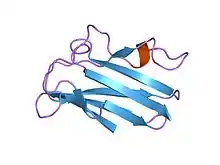Plastocyanin family of copper-binding proteins
Plastocyanin/azurin family of copper-binding proteins (or blue (type 1) copper domain) is a family of small proteins that bind a single copper atom and that are characterised by an intense electronic absorption band near 600 nm (see copper proteins).[2][3] The most well-known members of this class of proteins are the plant chloroplastic plastocyanins, which exchange electrons with cytochrome c6, and the distantly related bacterial azurins, which exchange electrons with cytochrome c551. This family of proteins also includes amicyanin from bacteria such as Methylobacterium extorquens or Paracoccus versutus (Thiobacillus versutus) that can grow on methylamine; auracyanins A and B from Chloroflexus aurantiacus;[4] blue copper protein from Alcaligenes faecalis; cupredoxin (CPC) from Cucumis sativus (Cucumber) peelings;[5] cusacyanin (basic blue protein; plantacyanin, CBP) from cucumber; halocyanin from Natronomonas pharaonis (Natronobacterium pharaonis),[6] a membrane-associated copper-binding protein; pseudoazurin from Pseudomonas; rusticyanin from Thiobacillus ferrooxidans;[7] stellacyanin from Rhus vernicifera (Japanese lacquer tree); umecyanin from the roots of Armoracia rusticana (Horseradish); and allergen Ra3 from ragweed. This pollen protein has evolutary relation to the above proteins, but seems to have lost the ability to bind copper. Although there is an appreciable amount of divergence in the sequences of all these proteins, the copper ligand sites are conserved.
| Copper binding proteins, plastocyanin/azurin family | |||||||||
|---|---|---|---|---|---|---|---|---|---|
 Structure of poplar plastocyanin.[1] | |||||||||
| Identifiers | |||||||||
| Symbol | Copper-bind | ||||||||
| Pfam | PF00127 | ||||||||
| InterPro | IPR000923 | ||||||||
| PROSITE | PDOC00174 | ||||||||
| SCOP2 | 1plc / SCOPe / SUPFAM | ||||||||
| OPM superfamily | 93 | ||||||||
| OPM protein | 1sfd | ||||||||
| CDD | cd00920 | ||||||||
| |||||||||
References
- Guss JM, Bartunik HD, Freeman HC (December 1992). "Accuracy and precision in protein structure analysis: restrained least-squares refinement of the structure of poplar plastocyanin at 1.33 A resolution". Acta Crystallogr. B. 48 (6): 790–811. doi:10.1107/S0108768192004270. PMID 1492962.
- Clingeleffer DJ, Guss JM, Rogers SJ, Freeman HC, Garrett TP (1984). "The crystal structure of poplar apoplastocyanin at 1.8-A resolution. The geometry of the copper-binding site is created by the polypeptide". J. Biol. Chem. 259 (5): 2822–2825. doi:10.2210/pdb2pcy/pdb. PMID 6698995.
- Hunt LT, Ryden LG (1993). "Evolution of protein complexity: the blue copper-containing oxidases and related proteins". J. Mol. Evol. 36 (1): 41–66. doi:10.1007/BF02407305. PMID 8433378. S2CID 28527197.
- Meyer TE, Han J, McManus JD, Brune DC, Sanders-Loehr J, Cusanovich MA, Tollin G, Blankenship RE (1992). "Isolation, characterization, and amino acid sequences of auracyanins, blue copper proteins from the green photosynthetic bacterium Chloroflexus aurantiacus". J. Biol. Chem. 267 (10): 6531–6540. PMID 1313011.
- Messerschmidt A, Mann K, Thoenes U, Mehrabian Z, Nalbandyan R, Schafer W (1992). "The amino acid sequence of a type I copper protein with an unusual serine- and hydroxyproline-rich C-terminal domain isolated from cucumber peelings". FEBS Lett. 314 (3): 220–223. doi:10.1016/0014-5793(92)81475-2. PMID 1468551. S2CID 24911765.
- Oesterhelt D, Mattar S, Scharf B, Rodewald K, Engelhard M, Kent SB (1994). "The primary structure of halocyanin, an archaeal blue copper protein, predicts a lipid anchor for membrane fixation". J. Biol. Chem. 269 (21): 14939–14945. PMID 8195126.
- Yano T, Fukumori Y, Yamanaka T (1991). "The amino acid sequence of rusticyanin isolated from Thiobacillus ferrooxidans". FEBS Lett. 288 (1): 159–162. doi:10.1016/0014-5793(91)81025-4. PMID 1879547. S2CID 37485952.